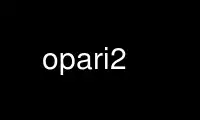
This is the command opari2 that can be run in the OnWorks free hosting provider using one of our multiple free online workstations such as Ubuntu Online, Fedora Online, Windows online emulator or MAC OS online emulator
PROGRAM:
NAME
opari - source to source OpenMP program instrumentor
SYNOPSIS
opari
[-f70|-f90|-c|-c++]
[-disable <construct>[,<construct>]...]
[-rcfile file] [-table <tabfile>] <infile> [<outfile>]
opari
[-rcfile <file>] -table <tabfile>
DESCRIPTION
Before compiling the source files of an OpenMP application, each file needs to be
transformed by a call to the OPARI tool. In addition, the application has to be linked
against the pomp runtime measurement library and the OPARI runtime table file. The latter
has to be generated by using the -table option to OPARI either together with the
transformation of the last input source file or with a separate call to OPARI after all
transformations are done.
If the output file name is not specified, OPARI uses the name infile.mod.suffix if the
input file is called infile.suffix.
OPTIONS
-f70, -f90, -c, -c++
[OPTIONAL] Specifies the programming language of the input source file. This option
is only necessary if the automatic language detection based on the input file
suffix fails.
-rcfile <file>
[OPTIONAL] OPARI uses the file ./opari.rc to preserve state information between
calls o OPARI if the OpenMP application consists of more than one source file. With
the -rcfile option the file file is used instead. This can be useful if more than
one application is stored in the same directory or if the source files of an
application are stored in more than more directory.
-table <tabfile>
Generate the OPARI runtime table in file tabfile. This option has to be used either
together with the call to OPARI for the transformation of the last input source
file or with a separate call to OPARI after all transformations are done.
-disable <construct>
[OPTIONAL] Disable the instrumentation of the more fine-grained OpenMP constructs
such as !$OMP ATOMIC. constructs is a comma separated list of the constructs for
which the instrumentation should be disabled. Accepted tokens are atomic, critical,
master, flush, single, or locks as well as sync to disable all of them.
Use opari2 online using onworks.net services
